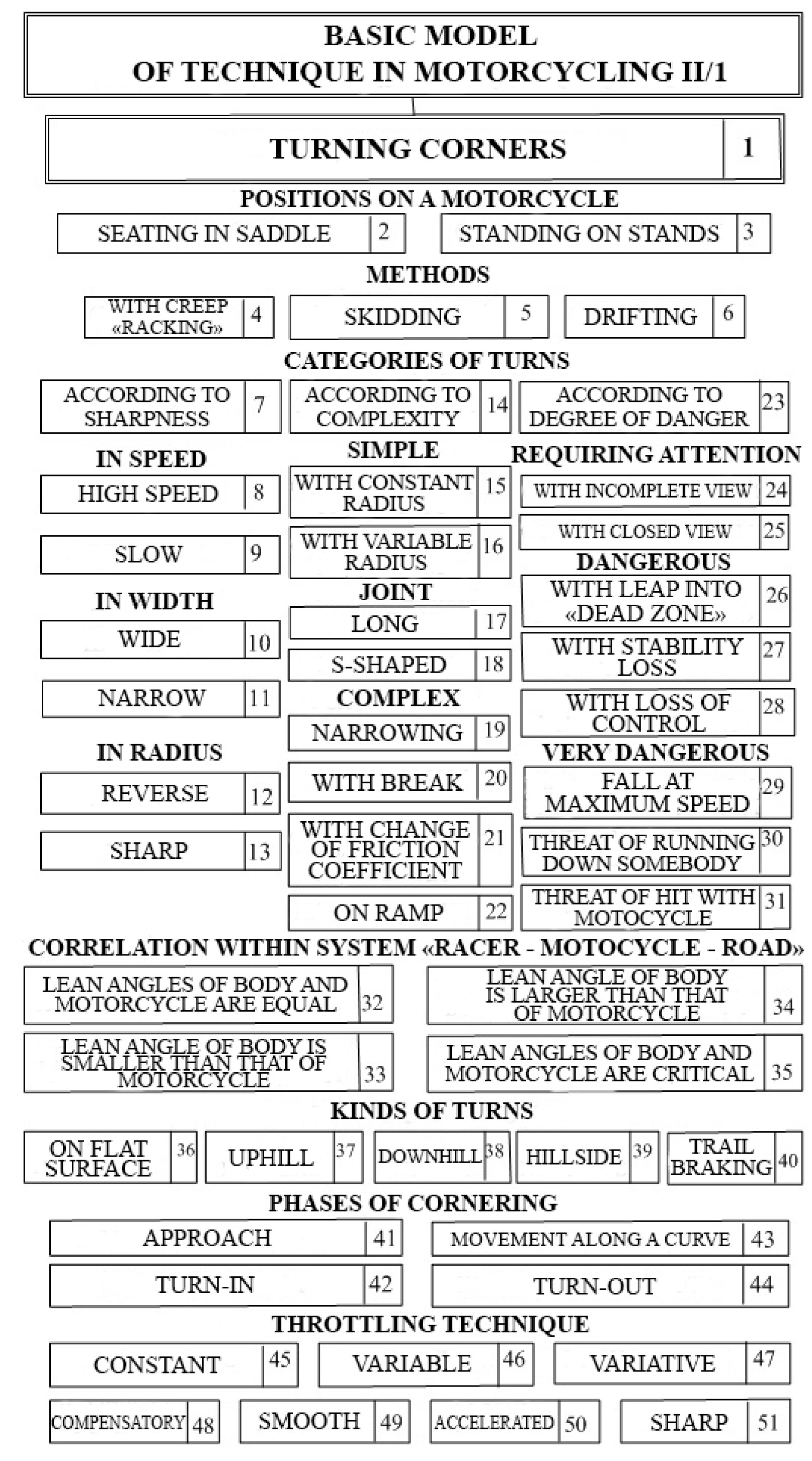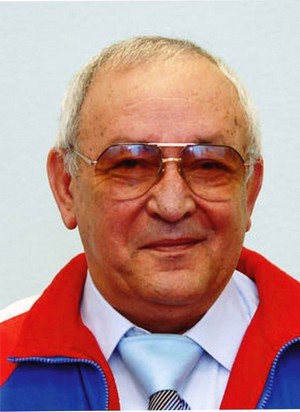Basic Model of Turn Technique in Motorcycling
Фотографии:
ˑ:
E.S. Tsygankov, professor, Dr.Hab., Honored Trainer of the RF, Honored Scientist of the RF,
G.I. Shulik, associate professor, Honored Trainer of the RSFSR
Russian State University of Physical Culture, Sport, Youth and Tourism, Moscow
Key words: categories of turns, ways of turning corners, racers’ positions, system “racer – motorcycle – road”.
Relevance. Formation of the educational model of teaching and training needs driver’s control actions to be worked out in detail. The suggested technology of turning corners is especially complicated due to generalization of experience in diverse elements of motorcycling disciplines.
Issue state. Turning corners (1) is to be considered as the most complex element of technical skills. Racer’s position on a motorcycle is defined by the specifics of the discipline, design of motorcycle, type of road surface (asphalt, gravel, soil, snow, ice). In most disciplines seat in the saddle is the original position on a motorcycle (2). In some disciplines (motocross, speedway, enduro, stuntriding) they use the pose of "standing on stands" (3). There are the following methods of cornering such as: "with creep racking" (4), "skidding" (5). The categories of turns vary in sharpness (7), speed - "high-speed" (8) and "slow" (9) in width - "wide" (10), "narrow" (11) and in radius - "reverse" (12) and "sharp" (13). According to the complexity (14) the categories of turns are divided into simple - "with constant radius" (15) and "variable radius" (16), into joint - "long" (17) and the “S-shaped" (18), into complex - "narrowing" (19), "with break" (20), "with change of friction coefficient" (21), "on ramp" (22). The categories of turns are divided "according to the degree of danger" (23): into requiring attention - "with incomplete view" (24), "closed view" (25); into dangerous - "with leap into "dead zone" (26), "with stability loss" (27), "with loss of control" (28); and into very dangerous - "fall at maximum speed" (29), "threat of running down somebody" (30), "threat of hit with a motorcycle"(31).
Table.

The value of the overturning couple in a turn is controlled by means of leaning of a body and a motorcycle. Safety in the system "racer - motorcycle - road" is preserved by different lean angles of a motorcycle, which are critical in ice racing and in closed-circuit road racing (35), and joint when lean angles of a body and a motorcycle are equal (32), lean angle of a body is smaller than that of a motorcycle (33), and lean angle of a body is larger than that of a motorcycle (34).
The essential feature of cornering technique is control over leaning and speed on the trajectory with maximal use of the friction coefficient. Among motorcycling disciplines, motocross and other disciplines related to racing on an uneven surface are the most variable in respect to cornering technique. Turns can be flat (36), uphill (37) downhill (38), hillside (39), trail braking (40).
Referring to the experience of auto racers, sharpness of turns can marked in digital values. Rational system comprises 8 categories of turns, from zero to 8, which corresponds to a motorcycle 1600-1700 turn. In modern rally, auto racers distinguish 18 categories of turns, however, this approach is too complicated to be applied to motorcycling accreditation.
The next gradation of turns is determined by the geometry of movement, from simple turns with constant radius to joint ones, in which complex racing lines of variable radii and curve length, and also change in direction of movement when making S-shaped turns are traced. The concept of turning corners implies gradation of degrees of danger (attention!, danger!, high danger!). Danger evaluation depends on objective factors (low friction coefficient, unevenness of a curve, counter slope and others) and subjective factors (incomplete or closed view, hop, flip and jump in a turn curve, fear of falling and of having an accident, health and life hazards.
Turning corners is characterized by phase nature: approach (41), turn-in (42), movement along the curve (43), turn-out (44). In the approach phase a racer slows down by means of one of the braking techniques: engine braking, front-wheel or rear-wheel braking, with creep "racking". A racer often tries to complete a preparatory maneuver called "entry", that allows fitting a curve with the widest radius into a corner, which is defined by the term "smoothing racing line": turn-in (42) represents changing from moving straight to moving along the curve of a specified radius.
There are different types of the turn-in maneuver: smooth, sharp, deep, by skidding (5), and with creep "racking" after countersweeping, counterskidding or powerful skidding at the beginning of a curve. Ideally, movement along a curve (43) implies building a smoothing racing line, although does not exclude additional maneuvers with compulsory change of trajectory during competition. While moving along a curve balancing techniques, i.e. maintenance of stability and control, is of crucial importance.
Balance of stability is maintained by means of bending forward, backward and sideways. Balance and self-safety are achieved with the help of the inner foot, while loading the side stand with the other foot. In closed-circuit road racing and ice racing there is always a limit angle of a motorcycle inward a corner, when a knee of the inner foot may touch the track surface. Special emphasis is placed on throttling technique, since full traction suspension causes a motorcycle to fall after skidding, drifting, rotation.
Depending on the configuration of corners, friction coefficient, individual characteristics of a racer, the following types of throttling are distinguished: constant (45), variable (46), variative (47), as well as smooth (49), sharp (51) and accelerated (50). The "compensatory" method (48) is one of the variative throttling types, and it represents a reaction to loss of stability and control. Movement along a curve by smoothing racing line implies "cutting", which is observed in the "apex" (the sharpest part of a curve). When entering a corner they choose the right gear which may be changed when turning out or when loosing stability in a curve. Turn-out phase (44) is related to reduction of leaning of a motorcycle, increase of load on the rear wheel, increase of movement radius - "loosening". When it is no longer necessary to use a foot for self-safety, it is to be put back on a stand. At the same time, it is necessary to keep on pressing the outer stand in order to sustain low center of gravity, especially while cornering without using trail braking.
Conclusion.
The specifics of turning corners:
1. Athlete uses the front seat to reduce the overall center of gravity of the system "racer - motorcycle" regarding the track surface, loading the front wheel and increase of the coefficient of road adherence.
2. Finishing before turning the heavy braking of the system "racer - motorcycle".
3. Using stops and rutting of the track on the corner to maintain the desired speed.
4. Maintaining proper leaning of a motorcycle cornering via taxing.
5. Maintaining the optimum speed of turning corners by riding at favorable trajectories.
6. Ensuring using throttling effective acceleration turning out.
References
- Semics, Gary, Bales, Donnie. Pro Motocross and Enduro Motorcycle Riding Techniques / Gary Semics, Donnie Bales, USA, 2008. (In Russian)
- Trofimets, Yu.I. Motocross (education and training) / Yu.I. Trofimets. – Moscow: DOSAAF, 1990. (In Russian)
- Tsygankov, E.S. Higher driving school: textbook for universities / E.S. Tsygankov. – Moscow: Akademkniga, 2007. (In Russian)
- Shulik, G.I. Classification of motorcycling disciplines: guide / G.I. Shulik. – Moscow: NRMF, 2013. – 95 P. (In Russian)
Corresponding author: chgriv46@mail.ru



 Журнал "THEORY AND PRACTICE
Журнал "THEORY AND PRACTICE